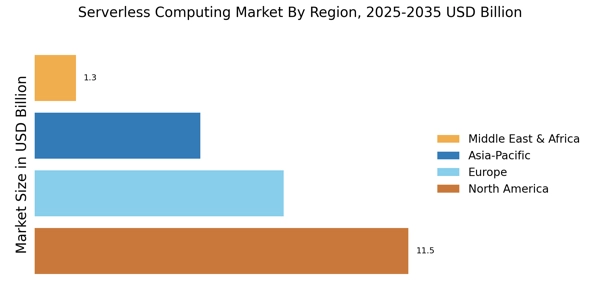The Serverless Computing Market is currently characterized by a dynamic competitive landscape, driven by rapid technological advancements and an increasing demand for scalable cloud solutions. Major players such as Amazon Web Services (US), Microsoft (US), and Google (US) are at the forefront, each adopting distinct strategies to enhance their market positioning. Amazon Web Services (US) continues to innovate with its Lambda service, focusing on expanding its capabilities to support a wider range of programming languages and frameworks. Meanwhile, Microsoft (US) emphasizes integration with its Azure platform, leveraging its existing enterprise relationships to drive adoption. Google (US) is also making strides by enhancing its Cloud Functions, aiming to attract developers with improved performance and cost efficiency. Collectively, these strategies not only intensify competition but also foster an environment ripe for innovation and customer-centric solutions.
In terms of business tactics, companies are increasingly localizing their services to cater to regional demands, optimizing their supply chains to enhance service delivery. The market structure appears moderately fragmented, with a mix of established giants and emerging players. This fragmentation allows for diverse offerings, yet the collective influence of key players like IBM (US) and Oracle (US) remains substantial, as they continue to invest in research and development to maintain competitive advantages.
In August 2025, Amazon Web Services (US) announced the launch of a new serverless architecture designed to enhance the scalability of enterprise applications. This strategic move is significant as it positions AWS to capture a larger share of the enterprise market, which is increasingly seeking flexible and efficient cloud solutions. By focusing on enterprise needs, AWS not only strengthens its market presence but also sets a benchmark for competitors.
In September 2025, Microsoft (US) unveiled a partnership with a leading financial services firm to integrate serverless computing into their operations. This collaboration is pivotal, as it showcases Microsoft's commitment to tailoring solutions for specific industries, thereby enhancing its value proposition. Such partnerships may lead to increased adoption rates among enterprises that require specialized cloud services.
In October 2025, Google (US) introduced a new pricing model for its Cloud Functions, aimed at reducing costs for developers. This strategic adjustment is likely to attract a broader developer base, particularly among startups and small businesses that are sensitive to pricing. By making serverless computing more accessible, Google positions itself as a competitive alternative in a market where cost efficiency is paramount.
As of October 2025, the competitive trends in the Serverless Computing Market are increasingly defined by digitalization, sustainability, and the integration of artificial intelligence. Strategic alliances are becoming more prevalent, as companies recognize the need to collaborate to enhance their technological capabilities. Looking ahead, competitive differentiation is expected to evolve, shifting from traditional price-based competition to a focus on innovation, technological advancements, and supply chain reliability. This transition underscores the importance of agility and responsiveness in meeting the diverse needs of a rapidly changing market.


















Leave a Comment